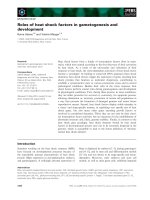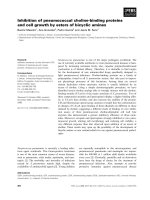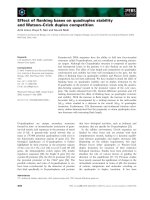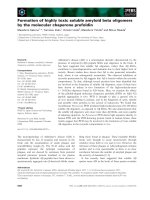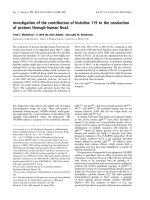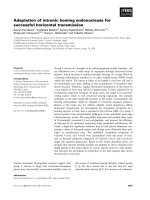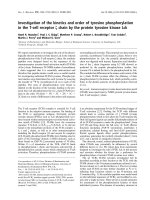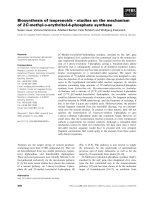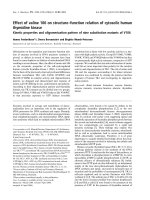Báo cáo khoa học: Investigation of the effects of sulfonylurea exposure on pancreatic beta cell metabolism pptx
Bạn đang xem bản rút gọn của tài liệu. Xem và tải ngay bản đầy đủ của tài liệu tại đây (237.62 KB, 9 trang )
Investigation of the effects of sulfonylurea exposure on
pancreatic beta cell metabolism
Lorraine Brennan
1
, Chandralal Hewage
1
, J. P. G. Malthouse
1
, Neville H. McClenaghan
2
,
Peter R. Flatt
2
and Philip Newsholme
1
1 UCD School of Biomolecular and Biomedical Science, UCD Conway Institute, University College Dublin, Belfield, Ireland
2 School of Biomedical Sciences, University of Ulster, Coleraine, UK
Sulfonylureas are a major class of potent insulinotrop-
ic drugs that are used extensively in the treatment of
patients with type 2 diabetes. These drugs stimulate
secretion of insulin from the pancreatic beta cell,
primarily by interacting with the high-affinity sulfonyl-
urea receptor (SUR1) subunit of the beta cell
ATP-sensitive potassium ion channel (K
ATP
) channel.
Sulfonylurea drugs differ in their specificity for the
SUR1 subunit. The interaction with the K
ATP
channel
closes the channel, causing membrane depolarization
and subsequent opening of voltage-dependent Ca
2+
channels [1]. The resulting influx of Ca
2+
leads to a
rapid rise in intracellular Ca
2+
concentration and trig-
gers insulin secretion [2,3]. However, a growing body
of evidence suggests that the sulfonylureas additionally
act in a K
ATP
channel-independent manner by directly
interacting with the secretory machinery, and it has
been suggested that this effect is indirectly dependent
on protein kinase C activation [4–6]. Interestingly, a
recent study has proposed a mechanism by which
sulfonylureas could be transported across the plasma
membrane and ultimately interact with intracellular
sites regulating insulin exocytosis [7].
Treatment of patients with sulfonylureas for pro-
longed periods (several years) often results in impaired
sulfonylurea-induced insulin secretion [8,9]. Although
the exact reasons underlying this phenomenon remain
unclear, it is now believed that this may be at least
partly attributed to desensitization of the pancreatic
beta cells to the actions of these drugs. Experiments
investigating the effects of chronic exposure of pancre-
atic islets and beta cell lines to sulfonylureas in vitro
have shown that the desensitization in certain cases
is not limited to subsequent drug-induced insulin
Keywords
beta cells; metabolism; sulfonylurea
Correspondence
L. Brennan, UCD School of Biomolecular
and Biomedical Science, UCD Conway
Institute, University College Dublin, Belfield,
Dublin 4, Ireland
Fax: +353 1 2837211
Tel: +353 1 7166781
E-mail:
(Received 9 June 2006, revised 21 Septem-
ber 2006, accepted 22 September 2006)
doi:10.1111/j.1742-4658.2006.05513.x
Prolonged exposure of pancreatic beta cells to the sulfonylureas glibenca-
mide and tolbutamide induces subsequent desensitization to the actions of
these drugs. The precise mechanisms underlying this desensitization remain
unknown, prompting the present study, which investigated the impact of
prolonged sulfonylurea exposure on glucose and energy metabolism using
clonal pancreatic BRIN-BD11 beta cells. Following prolonged exposure to
tolbutamide, BRIN-BD11 beta cells were incubated in the presence of
[U-
13
C]glucose, and isotopomer analysis revealed that there was a change
in the ratio of flux through pyruvate carboxylase (EC 6.4.1.1) and pyruvate
dehydrogenase (EC 1.2.4.1, EC 2.3.1.12, EC 1.8.1.4). Energy status in
intact BRIN-BD11 cells was determined using
31
P-NMR spectroscopy.
Exposure to tolbutamide did not alter the nucleotide triphosphate levels.
Collectively, data from the present study demonstrate that prolonged expo-
sure of beta cells to tolbutamide results in changes in flux through key
enzymes involved in glucose metabolism that, in turn, may impact on
glucose-induced insulin secretion.
Abbreviations
K
ATP
channel, ATP-sensitive potassium ion channel; NTP, nucleotide triphosphate; PC, pyruvate carboxylase; PDH, pyruvate dehydrogenase.
5160 FEBS Journal 273 (2006) 5160–5168 ª 2006 The Authors Journal compilation ª 2006 FEBS
secretion, but may also affect nutrient-induced insulin
secretion [10–13]. The precise mechanisms underlying
beta cell drug-induced desensitization remains elusive,
and it remains unclear as to whether it results from
depletion of insulin stores or functional changes in
signalling pathways [14]. In a study investigating
desensitization due to chronic exposure to glibenca-
mide in MIN6 cells, a decrease in the number of fun-
ctional K
ATP
channels on the plasma membrane was
observed [15]. This would support a homologous
desensitization theory, where the primary cause of the
desensitization is due to the occupancy of receptor
sites and subsequent modification of the downstream
pathways [14]. However, other studies have demon-
strated that prolonged treatment with sulfonylurea
drugs affects the subsequent secretory response to
other stimuli [12,13,16], indicating the presence of
heterogeneous desensitization.
Acute stimulation of insulin secretion by glucose
involves metabolism via oxidative and anaplerotic
pathways involving pyruvate dehydrogenase (PDH;
EC 1.2.4.1, EC 2.3.1.12, EC 1.8.1.4) and pyruvate
carboxylase (PC; EC 6.4.1.1) [17–19]. The resultant
increase in ATP concentration closes the K
ATP
chan-
nels, resulting in membrane depolarization, opening
of the voltage-dependent Ca
2+
channels, Ca
2+
influx,
and a subsequent increase in cytosolic Ca
2+
([Ca
2+
]
c
)
which in turn triggers insulin secretion. Additionally,
the influx of Ca
2+
results in an uptake of Ca
2+
by the
mitochondria, which may activate mitochondrial meta-
bolism and result in further increases in ATP concen-
tration [20–22]. The present study investigated the
effects of prolonged exposure to sulfonylurea drugs on
beta cell metabolism using a combination of different
NMR techniques, and utilizing the well-characterized
clonal glucose-responsive pancreatic beta cell line,
BRIN-BD11 [23,24].
Results
Metabolism of [1-
13
C]glucose in the presence and
absence of sulfonylurea(s)
Following 18 h of prior culture in the presence of tol-
butamide or glibencamide, the cells were incubated for
1 h in the presence of [1-
13
C]glucose with or without
the sulfonylurea drug. The main metabolites produced
included glutamate labelled at positions C2, C3 and
C4, lactate and alanine labelled at position C3, and
aspartate labelled at positions C2 and C3. Comparison
of the label distribution between the different treat-
ments indicated that there was no significant change
in the total concentration of glutamate labelled at
position C4 (Table 1). In the case of tolbutamide pre-
treatment, there was a general trend for decreased
labelling of glutamate in positions C2 and C3, but the
changes were significant only for the C2 position. The
total
13
C concentration of alanine and lactate labelled
at position C3 did not change significantly. However,
in the presence of tolbutamide, the total amount of
13
C label present in aspartate C2 and C3 increased
significantly. The percentage enrichments of the
glutamate peaks in the presence and absence of the
drugs are reported in Table 2. No significant changes
were observed for glutamate C3 and C4. In the
presence of tolbutamide, there was a decrease in the
percentage enrichment for glutamate C2. The amount
of glucose remaining in the medium was measured in
the presence and absence of drugs, and was found to
be significantly different only in the presence
of glibencamide; under control conditions, the amount
of glucose remaining was 19.5 ± 1.6 lmolÆmg
)1
protein, whereas in the presence of glibencamide,
the concentration was 14.3 ± 0.9 lmolÆmg
)1
protein
(P<0.005). The concentration of glucose remaining
in the medium after tolbutamide exposure was
17.9 ± 2.1 lmolÆmg
)1
protein. The insulin released
into the medium at the end of a 1 h incubation period
following the preculture with and without the drugs
Table 1. Amount of
13
C-labelled amino acids present after incuba-
tion for 1 h with [1-
13
C]glucose in the presence and absence of sul-
fonylurea drugs. Values are given as nmol per mg protein ± SD
(n ¼ 3). All experiments were carried out after a preincubation per-
iod of 18 h in the presence or absence of drug.
Control + Tolbutamide + Glibencamide
Glu C2 5.8 ± 1.0 3.6 ± 0.4* 5.7 ± 0.6
Glu C3 5.1 ± 1.0 3.8 ± 0.8 6.0 ± 1.1
Glu C4 15.8 ± 2.0 12.5 ± 1.0 17.9 ± 3.2
Lactate C3 7.5 ± 2.6 6.1 ± 2.8 6.2 ± 1.4
Alanine C3 4.8 ± 1.3 4.6 ± 1.3 4.1 ± 0.6
Asp C2 2.4 ± 0.5 4.0 ± 0.4* 2.6 ± 1.3
Asp C3 2.8 ± 0.2 4.9 ± 0.8* 2.6 ± 1.3
*P<0.05.
Table 2. Percentage enrichment in the glutamate carbons following
incubation for 1 h with [1-
13
C]glucose in the presence and absence
of sulfonylurea drugs. Values are expressed as a percentage ± SD
(n ¼ 3). All experiments were carried out after a preincubation
period of 18 h in the presence or absence of drug.
Control + Tolbutamide + Glibencamide
Glu C2 8.4 ± 0.6 6.6 ± 0.5* 8.3 ± 0.6
Glu C3 7.4 ± 1.6 7.0 ± 2.3 8.7 ± 1.2
Glu C4 22.8 ± 1.3 23.0 ± 3.0 26.0 ± 1.6
*P < 0.05.
L. Brennan et al. Metabolic effects of sulfonylurea exposure
FEBS Journal 273 (2006) 5160–5168 ª 2006 The Authors Journal compilation ª 2006 FEBS 5161
was measured. Preincubation in the presence of the
drugs significantly reduced the amount of insulin
released (Fig. 1).
Effects of tolbutamide and glibencamide on
[U-
13
C]glucose metabolism
To probe further the effect of tolbutamide and to
investigate the observed increase in aspartate produc-
tion, flux analysis was carried out using [U-
13
C]glu-
cose. Following prior culture for 18 h in the presence
of tolbutamide, BRIN-BD11 cells were incubated in
the presence of tolbutamide and [U-
13
C]glucose for
2 h. Control experiments were run in parallel with no
drug present. A typical spectrum obtained from con-
trol cellular extracts is shown in Fig. 2. There was no
significant change in the total amount of labelled glu-
tamate, lactate or alanine produced following culture
with tolbutamide (data not shown). The ratio of the
flux through PC and PDH was determined in the pres-
ence and absence of the drug, as described in Experi-
mental procedures (Table 3). A significant reduction in
the ratio was found in the presence of tolbutamide.
The fraction of acetyl-CoA derived from [U-
13
C]glu-
cose was determined, and is reported in Table 4.
Preincubation with tolbutamide did not change the
percentage significantly, indicating that the fraction of
glucose entering the tricarboxylic acid cycle via the
PDH-mediated conversion to acetyl-CoA did not
0
1
2
3
4
5
6
7
control
tol glib
Insulin release
[pmol·(mg protein)
–1
]
*
*
Fig. 1. Effects of culture (18 h) with 100 lM tolbutamide (Tol) or
1 l
M glibencamide (Glib) on glucose-induced insulin release over a
subsequent 1 h incubation period. Values are mean ± SD. Control
conditions refer to culture and subsequent incubation in the
absence of a drug. *P < 0.05.
Dioxane
Glucose
Glu C2
Glu C4
Glu C3
Lac C3
Ala C3
Ala C2
Acetate C2
Glucose
80 70 60 50 40 30 20
Chemical Shift (p.p.m.)
Fig. 2. A typical
13
C-NMR spectrum obtained for control conditions after incubation in the presence of 8.4 mM [U-
13
C]glucose for 2 h. Lac,
lactate.
Table 3. Ratio of flux through pyruvate carboxylase (PC) and pyru-
vate dehydrogenase (PDH) calculated from C2 and C4 resonances
of glutamate in the presence and absence of a sulfonylurea drug.
For all experiments, cells were incubated in the presence of
[U-
13
C]glucose for 2 h following 18 h of prior culture in the presence
or absence of the drug. Values are expressed as averages ± SD.
Condition PC ⁄ PDH
Control (n ¼ 3) 0.34 ± 0.04
Tolbutamide (n ¼ 3) 0.24 ± 0.02*
Glibencamide (n ¼ 2) 0.30 ± 0.01
*P < 0.05.
Table 4. Percentage of acetyl-CoA derived from [U-
13
C]glucose fol-
lowing incubation in the presence and absence of a sulfonylurea
drug. Values are expressed as a percentage ± SD. Cells were incu-
bated in the presence of [U-
13
C]glucose with or without a drug for
2 h following a preincubation period of 18 h in the presence or
absence of a drug.
Condition
Percentage labelled
from [U-
13
C]glucose
Control (n ¼ 3) 66 ± 10
Tolbutamide (n ¼ 3) 65 ± 5
Glibencamide (n ¼ 2) 76 ± 1
Metabolic effects of sulfonylurea exposure L. Brennan et al.
5162 FEBS Journal 273 (2006) 5160–5168 ª 2006 The Authors Journal compilation ª 2006 FEBS
change. Thus, the observed change in the ratio of flux
through PC and PDH must have been due to changes
in anaplerotic metabolism through PC.
When cells were preincubated in the presence of
glibencamide followed by [U-
13
C]glucose, the ratio of
the flux through PC and PDH did not differ signifi-
cantly from the control value.
31
P-NMR studies of intact pancreatic BRIN-BD11
beta cells
A typical spectrum obtained from cells grown on fibra-
cel beads in a mini-bioreactor is shown in Fig. 3. The
T1 (longitudinal relaxation) values for the NTP peaks
were calculated using inversion recovery experiments.
The following values were found: a, 0.65 ± 0.14 s;
b, 0.55 ± 0.05 s; and c, 0.88 ± 0.19 s. Control condi-
tions represent conditions where cells were maintained
in standard RPMI-1640 medium supplemented with
2mm glutamine, 10% (v ⁄ v) fetal bovine serum, and
0.1% antibiotics. When tolbutamide was added to the
culture medium to give a final concentration of
100 lm, there were no significant changes in the nuc-
leotide triphosphate (NTP) levels over a 24 h period
(Fig. 4). The free cytoplasmic ADP concentration is
directly proportional to the phosphocreatine ⁄ ATP
ratio [25,26]. There was no significant change in this
ratio on addition of tolbutamide, which, in the absence
of a change in the intracellular pH or total creatine
pool, indicated that there was no change in free ADP
concentration.
Discussion
Previous studies using clonal pancreatic BRIN-BD11
beta cells have demonstrated that prolonged exposure
(18 h) to sulfonylureas induces specific and readily
reversible desensitization to subsequent treatment with
the drugs [13,27]. It has also been reported that chro-
nic exposure (72–144 h) can result in an irreversible
concentration- and time-dependent decline in sulfonyl-
urea-induced insulin secretion [28]. As the mechanisms
underlying the latter effects remain to be determined,
the principal aim of this study was to investigate the
impact of sulfonylurea exposure on cellular metabo-
lism using clonal pancreatic BRIN-BD11 beta cells.
Under the experimental conditions used in this study,
there was a significant decrease in acute insulin release
following preincubation with the drugs compared to
control conditions. Previous studies on tolbutamide
have demonstrated that under the same conditions as
described in this study, the insulin content does not
change [27].
Prolonged exposure to tolbutamide and glibenca-
mide did not significantly alter the amount of glu-
tamate labelled at positions C4 and C3 following a
1 h incubation with [1-
13
C]glucose. The amount of
Chemical Shift (p.p.m.)
20 10 0 -10 -20
MDP
PCR
Pi
PME
NTP
Fig. 3. A typical
31
P-NMR spectrum of intact BRIN-BD11 cells grown in the mini-bioreactor. MDP, methylene diphosphonate; PME, phospho-
monoesters; Pi, inorganic phosphate; PCR, phosphocreatine; NTP, nucleotide triphosphate.
0
0.1
0.2
0.3
0.4
0.5
0.6
0 5 10 15 20 25 30 35 40
β
NTP/MDP
control tolbutamide
time (h)
Fig. 4. Nucleotide triphosphate levels in intact BRIN-BD11 cells
from a representative culture of cells. After a control period of
15 h, the cells were perfused in medium with 100 l
M tolbutamide
for 24 h.
L. Brennan et al. Metabolic effects of sulfonylurea exposure
FEBS Journal 273 (2006) 5160–5168 ª 2006 The Authors Journal compilation ª 2006 FEBS 5163
label at the C2 position showed a small decrease fol-
lowing incubation in the presence of tolbutamide.
The amount of labelled lactate and alanine did not
significantly change following incubation with either
drug. However, following prolonged exposure to tol-
butamide, the amount of aspartate labelled at posi-
tions C2 and C3 significantly increased. Aspartate
can be formed via a transamination reaction with
oxaloacetate, which is itself produced from pyruvate
via a reaction catalysed by PC. Oxaloacetate is in
equilibrium with malate, which can leave the mitoch-
ondrial matrix and in the cytosol is converted back
to pyruvate via malic enzyme (pyruvate cycling). To
gain a better understanding of these changes, experi-
ments were subsequently performed using [U-
13
C]glu-
cose, and analysis of the isotopomers formed allowed
calculation of the fluxes through specific enzymes
(Fig. 5).
A decrease in the ratio of fluxes through PC and
PDH (PC ⁄ PDH) was determined following 18 h of
exposure to tolbutamide. However, there was no
change in the fraction of acetyl-CoA labelled from
[U-
13
C]glucose via the PDH pathway, indicating that
the change in ratio was attributable to a reduction in
the flux through PC. Notably, other studies investi-
gating the acute effects of glibencamide and megliti-
nide on glucose oxidation in mouse pancreatic islets
found no inhibitory effects, consistent with our obser-
vations that oxidative pathways of glucose metabolism
remain unchanged [29]. In recent years, the importance
of flux through anaplerotic pathways in beta cells has
been highlighted. Cline et al. [30] reported a strong
positive correlation between insulin secretion and PC
flux in INS-1 cells. Furthermore, Lu et al. demonstra-
ted that the responsiveness of INS-1 cells to glucose-
stimulated insulin secretion was linked to the cycling
[31] of pyruvate (i.e. the flux through the pyruvate–
malate and pyruvate–citrate cycles). In a recent study,
Fransson et al. showed, by use of a PC inhibitor, the
importance of flux through PC for responsiveness to
glucose [32]. In the present study, the observed
decrease in flux through PC observed after prolonged
exposure to tolbutamide may be a contributary factor
to the resulting drug-induced desensitization to acute
stimulation by glucose.
The present data also indicate differential effects of
the two sulfonylureas on beta cell metabolism, as glib-
encamide did not change end-product concentrations
or the ratio of fluxes through PC and PDH. Preincu-
bation with either of the drugs resulted in reduction of
subsequent glucose-stimulated insulin release, suggest-
ing that there is not a common mechanism of desensi-
tization. However, in the present studies, a relatively
low concentration of glibencamide (1 l m) was used,
due to the reported higher affinity of this drug for
K
ATP
channels [33] compared to tolbutamide. Glyb-
encamide at 1 lm induces a similar secretory response
to that observed for 100 lm tolbutamide [16,34,35].
Early studies investigating the effects of sulfonyl-
ureas on ATP levels reported reduced concentrations
in islets [36–38]. More recently Elmi et al. [29] showed
that glibencamide reduced ATP concentration in the
absence of glucose, but the effects were not observed
at 10 mm glucose. These observations were used to
suggest that the reduced ATP levels may result from
increased consumption of ATP by activation of the
Na
+
⁄ K
+
pump. This is consistent with the results of a
31
P-NMR study of intact b-HC9 cells, which revealed
OAA
citrate
α-KG
malate
[U-
13
C]glucose
pyruvate
Acetyl-CoA
PC
PDH
PDH
PC
glu glu glu
PC
aspartate
1
2
3
4
5
Fig. 5. Overview of the metabolism of
[U-
13
C]glucose. For simplicity, only the iso-
topomers of glutamate formed after one
turn of the tricarboxylic acid cycle (TCA) are
shown. The filled circles represent labelling
of the carbon position with
13
C. [U-
13
C]Pyru-
vate enters the TCA cycle via pyruvate
dehydrogenase (PDH), forming
[1,2-
13
C]acetyl-CoA and consequently
[4,5-
13
C]glutamate. If pyruvate enters via
pyruvate carboxylase (PC), two
13
C isotopo-
mers of oxaloacetate are derived,
[1,2,3-
13
C]oxaloacetate and [3,4-
13
C]oxalo-
acetate, consequently leading to
[2,3-
13
C]glutamate and [1,2,3-
13
C]glutamate
[48]. Glu, glutamate; OAA, oxaloacetate;
a-KG, a-ketoglutarate.
Metabolic effects of sulfonylurea exposure L. Brennan et al.
5164 FEBS Journal 273 (2006) 5160–5168 ª 2006 The Authors Journal compilation ª 2006 FEBS
that ATP levels did not change on addition of the sul-
fonylurea glyburide at glucose concentrations of 5 mm
[39]. However, another study using MIN-6 cells
showed that if the cells were initally primed with tol-
butamide (200 lm), the subsequent increase in ATP in
response to 30 mm glucose was potentiated [40]. All of
these studies are distinct from ours, in that they
focused on the effects of acute sulfonylurea exposure,
whereas we examined the effects of prolonged exposure
on ATP levels using
31
P-NMR. Our data are consistent
with other studies, which reported no alteration in cel-
lular ATP levels after addition of sulfonylureas in the
presence of glucose.
Collectively, the present data demonstrate novel
changes to fluxes in glucose metabolism following pro-
longed exposure to the important sulfonylurea drug
tolbutamide, resulting in a 25% decrease in the
PC ⁄ PDH ratio. Furthermore, these data reveal a
reduction in anaplerotic flux through PC. These obser-
vations are notable in that they raise the possibility
that chronic sulfonylurea exposure in vivo may impact
on glucose metabolism, which may contribute to the
reported phenomena of sulfonylurea desensitization
and, indeed, sulfonylurea failure in type 2 diabetes.
Future studies determining the molecular mechanisms
of tolbutamide-mediated reduction in flux through PC
may lead to the design of more effective insulinotropic
drugs in the future.
Experimental procedures
Reagents
d-[1-
13
C]Glucose and d-[U-
13
C]glucose were obtained from
Goss Scientific (Great Baddow, Essex, UK). All other
chemicals were obtained from Sigma-Aldrich Chemical
Company (Poole, Dorset, UK). Culture media and fetal
bovine serum were obtained from Gibco (Glasgow, UK).
Treatment of BRIN-BD11 cells with drugs
Pancreatic BRIN-BD11 beta cells were utilized in these
studies [41], representing a particularly useful model in
which to conduct extensive NMR studies [23,24]. BRIN-
BD11 cells were maintained in RPMI-1640 tissue culture
medium with 10% (v ⁄ v) fetal bovine serum, 0.1% antibiot-
ics (100 UÆmL
)1
penicillin and 0.1 mgÆmL
)1
streptomycin)
and 11.1 mmd-glucose (pH 7.4). The cells were maintained
at 37 °C in a humidified atmosphere of 5% CO
2
and 95%
air using a Forma Scientific (Waltham, MA) incubator. For
experiments on prolonged exposure to sulfonylureas, the
cells were grown in T175 flasks and treated for 18 h in
the presence of the drug at the specified concentration
(tolbutamide 100 lm and glibencamide 1 lm). Cells were
then washed with NaCl ⁄ P
i
and preincubated at 37 °C for
20 min in Krebs ⁄ Ringer bicarbonate buffer with 1.1 mm
d-glucose (115 mm NaCl, 4.7 mm KCl, 1.28 mm CaCl
2
,
1.2 mm KH
2
PO
4
, 1.2 mm MgSO
4
.7H
2
O, 10 mm NaHCO
3
,
5gÆL
)1
BSA, pH 7.4). This was followed by incubation in
the presence of 8.4 mm labelled glucose ([1-
13
C]glucose or
[U-
13
C]glucose) and drug for a specified period (1 h or 2 h).
Control experiments were carried out in parallel in the
absence of the drug.
Following the incubation period, the medium was
removed and stored at ) 20 °C. Subsequently, the glucose
concentration and the insulin released were measured. The
insulin released was measured using a Mercodia (Uppsala,
Sweden) ultrasensitive rat insulin ELISA. The metabolites
were extracted using a perchloric acid extraction procedure.
Briefly, the cells were washed with ice-cold NaCl ⁄ P
i
. Per-
chloric acid (6%) was added, and the cells were scraped off
the culture flasks. The extracts of six culture flasks
(approximately 10
8
cells) were pooled and centrifuged at
200 g with a Sigma 2-15 rotor. The resulting supernatant
was neutralized with KOH (5 m and 0.1 m solutions), and
the pellets were soaked overnight in 0.1 m NaOH. The pro-
tein concentration was determined using the Lowry method
[42]. The neutralized supernatant was centrifuged (200 g
with a Sigma 2-15 rotor), and the supernatant was treated
with Chelex-100 resin and then lyophilized. Each experi-
ment was carried out on at least two independent cultures
of the BRIN-BD11 cells. The lyophilized cell extracts were
dissolved in 3 mL of potassium phosphate buffer (100 mm,
pH 7.0) and then centrifuged at 200 g with a Sigma 2-15
rotor. The supernatant was carefully removed, 10% D
2
O
was added, and the pH was checked and adjusted when
necessary with 0.1 m NaOH and 0.1 m HCl. NMR experi-
ments were performed as detailed below.
Culture of BRIN-BD11 cells at high density in a
mini-bioreactor
A system was set up to monitor energy metabolism in
intact BRIN-BD11 cells as previously described [43].
Briefly, it consists of a 2 L stirred tank fermenter in which
the temperature, pH, CO
2
content and dissolved O
2
content
of the culture medium were monitored and maintained
within a specified range. The mini-bioreactor is a purpose-
built bioreactor consisting of a capped polysulfone tube
(10 mm diameter) with an inlet tube and an outlet tube.
Cells were maintained attached to fibracel disks (New
Brunswick Scientific, Edison, NJ) in the mini-bioreactor
and were perfused with medium from the fermenter, which
was pumped to the mini-bioreactor in the NMR magnet
via water-jacketed tubing at 37 °C. Medium in the ferment-
er was replaced by fresh medium using a ‘feed and bleed’
system. By adjustment of the feed and bleed system,
L. Brennan et al. Metabolic effects of sulfonylurea exposure
FEBS Journal 273 (2006) 5160–5168 ª 2006 The Authors Journal compilation ª 2006 FEBS 5165
nutrients can be maintained at a certain level. For seeding
of the bioreactor, the cells were pumped into the mini-bio-
reactor as a slow rate over a period of 2 h. Typically
1 · 10
8
to 3 · 10
8
cells were passed through the carriers,
and attachment of 85–90% of the cells was routinely
found.
NMR spectroscopy
13
C-NMR of perchloric acid extracts
For
13
C-NMR experiments, an insert containing 5% v ⁄ v
dioxane in water was used as an external signal intensity
reference. A solution of l-alanine, l-glutamate, lactate and
d-glucose, each at a concentration of 100 mm, was prepared
and used to quantitate concentrations of metabolites in the
13
C spectra. Proton-decoupled
13
C spectra were acquired on
a Bruker (Karlsruhe, Germany) DRX 500 spectrometer
using a 10 mm broadband probe. Typically, spectra were
acquired with 32 000 data points using 90° pulses,
260 p.p.m. spectral width, 2.5 s relaxation delay, and
12 000–20 000 scans. Spectra were recorded at 25 °C.
Chemical shifts were referenced to tetramethylsilane at
0 p.p.m. Data were processed with no zero filling using
Bruker winnmr software, and exponential multiplications
with 2 Hz line broadening were performed. The assign-
ments of the intermediate metabolites were made by com-
parison with chemical shift tables in the literature [44] or
by addition of 100 mm unlabelled amino acid. The amount
of
13
C in each resonance was evaluated by integration of
the extract peaks and the corresponding peaks in the stand-
ard sample relative to the dioxane signal. Corrections for
the natural abundance signal were made. In the case of the
aspartate peaks, the amount of
13
C was estimated by use of
the integrals and the known dioxane concentration. The
contributions of the individual isotopomers were assessed
using the deconvolution routines in winnmr. The absolute
enrichments of the l-glutamate were related to the glutam-
ate concentration in the extracts, determined by enzymatic
methods, to give the specific enrichments [45]. The fluxes
reported were obtained by analysis of the isotopomers of
glutamate C2 and C4. The ratio between flux through PC
and PDH was calculated as follows ([2,3-
13
C
2
]+
[1,2,3-
13
C
3
]) ⁄ [4,5-
13
C
2
] + [3,4,5-
13
C
3
] [46]. The fraction of
acetyl-CoA labelled from [U-
13
C]glucose was calculated
using the following equation for the C4 peak:
(3,4,5-
13
C) · C4 ⁄ C3 [47].
31
P-NMR of intact cells
Following removal of the upper barrel of the magnet, the
mini-bioreactor was carefully guided into the probe head
for the collection of NMR data with the aid of a custom-
built holder. Typically, spectra were acquired with 8000
data points using 90° pulses, 50 p.p.m. spectral width, 2.0 s
relaxation delay, and 512 scans. Spectra were recorded at
37 °C. Chemical shifts in aqueous media were referenced
to methylene diphosphonate at 17.0 p.p.m., which was
contained in a sealed capillary in the mini-bioreactor. Expo-
nential multiplications with 20 Hz line broadening were
performed using winnmr software. The three phosphate
groups in NTPs give three distinct peaks. These peaks were
primarily attributed to ATP. The T1 values of the NTP
peaks were determined using inversion recovery experiments
in three independent sets of cells, and these values were
then used to optimize the NMR acquisition parameters. To
investigate the effects of tolbutamide on energy metabolism,
the cells were perfused with medium containing 100 lm tol-
butamide for a period of 24 h. Spectra were recorded every
40 min. In some cases, slight acidification of the bioreactor
environment was apparent by appearance of a shoulder on
the P
i
peak attributed to intracellular P
i
. When this
occurred, the flow rate through the bioreactor was
increased as previously described [43].
Statistical analysis
The results are presented as mean ± SD for n separate
determinations. Groups of data were compared using
Student’s unpaired t-test. Differences were considered signi-
ficant at P < 0.05.
Acknowledgements
LB was in receipt of a Health Research Board of
Ireland postdoctoral fellowship, which is gratefully
acknowledged (PD ⁄ 2002 ⁄ 9).
References
1 Aguilar-Bryan L, Nichols CG, Wechsler SW, Clement
JPT, Boyd AE 3rd, Gonzalez G, Herrera-Sosa H,
Nguy K, Bryan J & Nelson DA (1995) Cloning of
the beta cell high-affinity sulfonylurea receptor: a
regulator of insulin secretion. Science 268, 423–426.
2 Henquin JC (1998) A minimum of fuel is necessary for
tolbutamide to mimic the effects of glucose on electrical
activity in pancreatic beta-cells. Endocrinology 139, 993–
998.
3 Ashcroft FM & Gribble FM (1998) Correlating struc-
ture and function in ATP-sensitive K+ channels.
Trends Neurosci 21, 288–294.
4 Eliasson L, Renstrom E, Ammala C, Berggren PO,
Bertorello AM, Bokvist K, Chibalin A, Deeney JT,
Flatt PR, Gabel J et al. (1996) PKC-dependent stimula-
tion of exocytosis by sulfonylureas in pancreatic beta
cells. Science 271, 813–815.
5 Tian YA, Johnson G & Ashcroft SJ (1998) Sulfonyl-
ureas enhance exocytosis from pancreatic beta-cells by a
Metabolic effects of sulfonylurea exposure L. Brennan et al.
5166 FEBS Journal 273 (2006) 5160–5168 ª 2006 The Authors Journal compilation ª 2006 FEBS
mechanism that does not involve direct activation of
protein kinase C. Diabetes 47 , 1722–1726.
6 Flatt PR, Shibier O, Szecowka J & Berggren PO (1994)
New perspectives on the actions of sulphonylureas and
hyperglycaemic sulphonamides on the pancreatic beta-
cell. Diabete Metab 20, 157–162.
7 Kamp F, Kizilbash N, Corkey BE, Berggren PO &
Hamilton JA (2003) Sulfonylureas rapidly cross
phospholipid bilayer membranes by a free-diffusion
mechanism. Diabetes 52, 2526–2531.
8 Pontiroli AE, Calderara A & Pozza G (1994) Secondary
failure of oral hypoglycaemic agents: frequency, possible
causes, and management. Diabetes Metab Rev 10, 31–43.
9 Matthews DR, Cull CA, Stratton IM, Holman RR &
Turner RC (1998) UKPDS 26: sulphonylurea failure in
non-insulin-dependent diabetic patients over six years.
UK Prospective Diabetes Study (UKPDS) Group.
Diabet Med 15, 297–303.
10 Gullo D, Rabuazzo AM, Vetri M, Gatta C, Vinci C,
Buscema M, Vigneri R & Purrello F (1991) Chronic
exposure to glibenclamide impairs insulin secretion in
isolated rat pancreatic islets. J Endocrinol Invest 14,
287–291.
11 Rabuazzo AM, Buscema M, Vinci C, Caltabiano V,
Vetri M, Forte F, Vigneri R & Purrello F (1992)
Glyburide and tolbutamide induce desensitization of
insulin release in rat pancreatic islets by different
mechanisms. Endocrinology 131, 1815–1820.
12 Ball AJ, Flatt PR & McClenaghan NH (2000) Desensi-
tization of sulphonylurea- and nutrient-induced insulin
secretion following prolonged treatment with glibencla-
mide. Eur J Pharmacol 408, 327–333.
13 McClenaghan NH, Ball AJ & Flatt PR (2001) Specific
desensitization of sulfonylurea- but not imidazoline-
induced insulin release after prolonged tolbutamide
exposure. Biochem Pharmacol 61, 527–536.
14 Rustenbeck I (2002) Desensitization of insulin secretion.
Biochem Pharmacol 63, 1921–1935.
15 Kawaki J, Nagashima K, Tanaka J, Miki T, Miyazaki
M, Gonoi T, Mitsuhashi N, Nakajima N, Iwanaga T,
Yano H et al. (1999) Unresponsiveness to glibenclamide
during chronic treatment induced by reduction of ATP-
sensitive K+ channel activity. Diabetes 48, 2001–2006.
16 Anello M, Gilon P & Henquin JC (1999) Alterations of
insulin secretion from mouse islets treated with sulpho-
nylureas: perturbations of Ca2+ regulation prevail over
changes in insulin content. Br J Pharmacol 127 , 1883–
1891.
17 MacDonald MJ (1993) Glucose enters mitochondrial
metabolism via both carboxylation and decarboxylation
of pyruvate in pancreatic islets. Metabolism 42, 1229–
1231.
18 Khan A, Ling ZC & Landau BR (1996) Quantifying the
carboxylation of pyruvate in pancreatic islets. J Biol
Chem 271, 2539–2542.
19 Schuit F, De Vos A, Farfari S, Moens K, Pipeleers D,
Brun T & Prentki M (1997) Metabolic fate of glucose in
purified islet cells. Glucose-regulated anaplerosis in beta
cells. J Biol Chem 272, 18572–18579.
20 McCormack JG, Halestrap AP & Denton RM (1990)
Role of calcium ions in regulation of mammalian
intramitochondrial metabolism. Physiol Rev 70, 391–425.
21 Rutter GA, Burnett P, Rizzuto R, Brini M, Murgia M,
Pozzan T, Tavare JM & Denton RM (1996) Subcellular
imaging of intramitochondrial Ca2+ with recombinant
targeted aequorin: significance for the regulation of
pyruvate dehydrogenase activity. Proc Natl Acad Sci
USA 93, 5489–5494.
22 Kennedy HJ, Pouli AE, Ainscow EK, Jouaville LS,
Rizzuto R & Rutter GA (1999) Glucose generates sub-
plasma membrane ATP microdomains in single islet
beta-cells. Potential role for strategically located mito-
chondria.
J Biol Chem 274, 13281–13291.
23 Brennan L, Shine A, Hewage C, Malthouse JP, Brindle
KM, McClenaghan N, Flatt PR & Newsholme P (2002)
A nuclear magnetic resonance-based demonstration of
substantial oxidative 1-alanine metabolism and l-ala-
nine-enhanced glucose metabolism in a clonal pancreatic
beta-cell line: metabolism of l -alanine is important to
the regulation of insulin secretion. Diabetes 51, 1714–
1721.
24 Brennan L, Corless M, Hewage C, Malthouse JP,
McClenaghan NH, Flatt PR & Newsholme P (2003)
13C NMR analysis reveals a link between l-glutamine
metabolism, d-glucose metabolism and gamma-glutamyl
cycle activity in a clonal pancreatic beta-cell line. Diabe-
tologia 46, 1512–1521.
25 Lawson JW & Veech RL (1979) Effects of pH and free
Mg2+ on the Keq of the creatine kinase reaction and
other phosphate hydrolyses and phosphate transfer
reactions. J Biol Chem 254 , 6528–6537.
26 Matthews PM, Bland JL, Gadian DG & Radda GK
(1982) A 31P-NMR saturation transfer study of the
regulation of creatine kinase in the rat heart. Biochim
Biophys Acta 721, 312–320.
27 McClenaghan NH, Ball AJ & Flatt PR (2000) Induced
desensitization of the insulinotropic effects of antidia-
betic drugs, BTS 67 582 and tolbutamide. Br J Pharma-
col 130, 478–484.
28 Ball AJ, McCluskey JT, Flatt PR & McClenaghan NH
(2004) Chronic exposure to tolbutamide and glibencla-
mide impairs insulin secretion but not transcription of
K(ATP) channel components. Pharmacol Res 50, 41–
46.
29 Elmi A, Idahl LA & Sehlin J (2000) Relationships
between the Na(+) ⁄ K(+) pump and ATP and ADP
content in mouse pancreatic islets: effects of meglitinide
and glibenclamide. Br J Pharmacol 131, 1700–1706.
30 Cline GW, Lepine RL, Papas KK, Kibbey RG &
Shulman GI (2004) 13C NMR isotopomer analysis of
L. Brennan et al. Metabolic effects of sulfonylurea exposure
FEBS Journal 273 (2006) 5160–5168 ª 2006 The Authors Journal compilation ª 2006 FEBS 5167
anaplerotic pathways in INS-1 cells. J Biol Chem 279,
44370–44375.
31 Lu D, Mulder H, Zhao P, Burgess SC, Jensen MV,
Kamzolova S, Newgard CB & Sherry AD (2002) 13C
NMR isotopomer analysis reveals a connection between
pyruvate cycling and glucose-stimulated insulin secretion
(GSIS). Proc Natl Acad Sci USA 99, 2708–2713.
32 Fransson U, Rosengren AH, Schuit FC, Renstrom E &
Mulder H (2006) Anaplerosis via pyruvate carboxylase is
required for the fuel-induced rise in the ATP:ADP ratio
in rat pancreatic islets. Diabetologia 49, 1578–1586.
33 Panten U, Burgfeld J, Goerke F, Rennicke M,
Schwanstecher M, Wallasch A, Zunkler BJ & Lenzen S
(1989) Control of insulin secretion by sulfonylureas,
meglitinide and diazoxide in relation to their binding to
the sulfonylurea receptor in pancreatic islets. Biochem
Pharmacol 38, 1217–1229.
34 McClenaghan NH & Flatt PR (1999) Physiological and
pharmacological regulation of insulin release: insights
offered through exploitation of insulin-secreting cell
lines. Diabetes Obes Metab 1, 137–150.
35 Groop LC (1992) Sulfonylureas in NIDDM. Diabetes
Care 15, 737–754.
36 Hellman B, Idahl LA & Danielsson A (1969) Adenosine
triphosphate levels of mammalian pancreatic B cells
after stimulation with glucose and hypoglycemic sulfo-
nylureas. Diabetes 18, 509–516.
37 Welsh M (1983) The effects of glibenclamide on rat islet
radioactive nucleotide efflux, ATP contents and respirat-
ory rates. Biochem Pharmacol 32, 2903–2908.
38 Detimary P, Gilon P & Henquin JC (1998) Interplay
between cytoplasmic Ca2+ and the ATP ⁄ ADP ratio: a
feedback control mechanism in mouse pancreatic islets.
Biochem J 333, 269–274.
39 Doliba NM, Vatamaniuk MZ, Buettger CW, Qin W,
Collins HW, Wehrli SL, Carr RD & Matschinsky FM
(2003) Differential effects of glucose and glyburide on
energetics and Na+ levels of betaHC9 cells: nuclear
magnetic resonance spectroscopy and respirometry stud-
ies. Diabetes 52, 394–402.
40 Ainscow EK & Rutter GA (2001) Mitochondrial prim-
ing modifies Ca2+ oscillations and insulin secretion in
pancreatic islets. Biochem J 353, 175–180.
41 McClenaghan NH, Barnett CR, Ah-Sing E, Abdel-
Wahab YH, O’Harte FP, Yoon TW, Swanston-Flatt
SK & Flatt PR (1996) Characterization of a novel
glucose-responsive insulin-secreting cell line, BRIN-
BD11, produced by electrofusion. Diabetes 45,
1132–1140.
42 Lowry OH, Rosebrough NJ, Farr AL & Randall RJ
(1951) Protein measurement with the Folin phenol
reagent. J Biol Chem 193, 265–275.
43 Thelwall PE & Brindle KM (1999) Analysis of CHO-K1
cell growth in a fixed bed bioreactor using magnetic
resonance spectroscopy and imaging. Cytotechnology 30,
121–132.
44 Fan TWM (1996) Metabolite profiling by one- and
two-dimensional NMR analysis of complex
mixtures. Prog Nucl Magnet Reson Spectrosc 28,
161–219.
45 Chateil J, Biran M, Thiaudiere E, Canioni P & Merle
M (2001) Metabolism of [1-(13)C) glucose and [2-
(13)C]acetate in the hypoxic rat brain. Neurochem Int
38, 399–407.
46 Lapidot A & Gopher A (1994) Cerebral metabolic com-
partmentation. Estimation of glucose flux via pyruvate
carboxylase ⁄ pyruvate dehydrogenase by 13C NMR iso-
topomer analysis of D-[U-13C]glucose metabolites.
J Biol Chem 269, 27198–27208.
47 Malloy CR, Sherry AD & Jeffrey FM (1990) Analysis
of tricarboxylic acid cycle of the heart using 13C isotope
isomers. Am J Physiol 259, H987–H995.
48 Haber S & Lapidot A (2001) Energy fuel utilization by
fetal versus young rabbit brain: a 13C MRS isotopomer
analysis of [U-(13)C]glucose metabolites. Brain Res 896,
102–117.
Metabolic effects of sulfonylurea exposure L. Brennan et al.
5168 FEBS Journal 273 (2006) 5160–5168 ª 2006 The Authors Journal compilation ª 2006 FEBS
